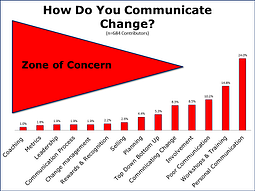To attend a webinar on this topic or other topics covered in Focusing Change to Win go to http://focusingchangetowin.com/webinar/. Use the comment form below or email us directly at admin@tbointl.com to ask a question or to open a dialogue with the author or one of our other team members.

In this seventh post, based on Nick Anderson's book, Focusing Change to Win, we highlight contributions from 1072 Business Leaders. This post gives some of the key findings on effective communications and how they impact resistance and ultimately change success. The following is based on 684 contributors who chose to add comments on communicating change. Unsurprisingly, contributors see their people at the heart of any successful change process. They see gaining stakeholder commitment and creating a cadre of change ambassadors as a force multiplier. Essential to creating that commitment are leaders taking their people into their confidence with honesty and courage.

Surprisingly, however, our analysis also sheds light on some blind spots. Overall contributors focus more on technique than systemic or strategic issues when communicating change. For example:
"They (Leaders) lack the ability to motivate or hold people accountable….they do a poor job at this…..lots of saying nothing….People are told, not asked."
Real change requires authentic communication and dialogue across all organizational levels. Although, employee’s resistance and disagreement are unavoidable, contributors show how it can be managed through multiplexed and constant communication. They stress that this only happens when change communication is centered on establishing and retaining trusting relationships. If employees feel fairness, they will trust more and trust is the glue of success.
So, what role does communication play in reducing change mistrust and cynicism among employees? Frequently, it’s people’s sense of fairness. The communication timing, involvement and sequence impact their sense of justice.
There seems little focus on improving alignment and change success. Issues like change management, communication, and change measurement were under 6% of contributors’ comments on communicating change.
Looking in more detail, a third of contributors said that they didn’t know of any change related communication or that their leaders don’t communicate enough. However, comments on authentic communication and building trust seem to collide with those related to top down led change. Critical contributors point out that top down rests too often on leaders clinging to the belief that power, privilege and success lie in their core group. Whatever blend of top down and bottom up it is clear – one should be intentional and as one contributor said:
"Being solid in the values you hold as a leader that needs clearly articulating and solidifying with your change management team before you start planning."

Our contributors are clear. Lay the groundwork for successful change before trying to carry out the next change. This starts with putting the change management team together before a specific change is planned. Then develop a shared governing set of values and design the change measurement framework.
Action Point: See your Communications from the Employee and Stakeholder Perspective

This list represents one perspective on reviewing the quality and effectiveness of communications. For a more complete assessment see Focusing Change to Win, Section 7, Pages 157 to 164.
To attend a webinar on this topic or other topics covered in Focusing Change to Win, go to http://focusingchangetowin.com/webinar/. Use the comment form below or email us directly at admin@tbointl.com to ask a question or to open a dialogue with the author or one of our other team members.





